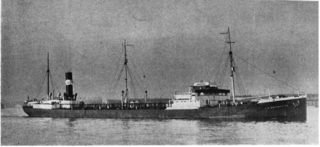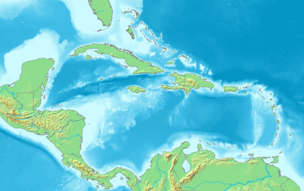SS Atlantic Empress was a Greek oil tanker that in 1979 collided with the oil tanker Aegean Captain in the Caribbean, and eventually sank, having created the fifth largest oil spill on record and the largest ship-based spill having spilled 287,000 metric tonnes of crude oil into the Caribbean Sea. It was built at the Odense Staalskibsværft shipyard in Odense, Denmark, and launched on 16 February 1974.

Lake tankers were small specially designed shallow-draft tanker ships that carried the crude oil, pumped from beneath Lake Maracaibo in Venezuela, to the three off-shore refineries located on the Dutch islands of Aruba and Curaçao.

German submarine U-511 was a Type IXC U-boat of Nazi Germany's Kriegsmarine during World War II. The submarine was laid down on 21 February 1941 at the Deutsche Werft yard in Hamburg as yard number 307, launched on 22 September 1941 and commissioned on 8 December 1941 under the command of Kapitänleutnant Friedrich Steinhoff.
Vorwärts was a wolfpack of German U-boats that operated from 25 August to 26 September 1942, in the Battle of the Atlantic during World War II. They attacked several convoys, principally Convoy ON 127, sailing from Liverpool to New York, and sank fifteen ships for a total of 79,331 gross register tons (GRT), and damaged nine (81,141 GRT).

The Battle of the Caribbean refers to a naval campaign waged during World War II that was part of the Battle of the Atlantic, from 1941 to 1945. German U-boats and Italian submarines attempted to disrupt the Allied supply of oil and other material. They sank shipping in the Caribbean Sea and the Gulf of Mexico and attacked coastal targets in the Antilles. Improved Allied anti-submarine warfare eventually drove the Axis submarines out of the Caribbean region.

W. L. Steed was a steam tanker built in 1917–1918 by Bethlehem Shipbuilding Corporation of Quincy for Pan American Petroleum and Transport Company, with intention of transporting oil and petroleum products between Mexican and Gulf ports and the Northeast of the United States. The ship was briefly requisitioned by the US Government during World War I but returned to commercial service in early 1919. The ship was named after William L. Steed, superintendent of the Mexican Petroleum Company of California.
MV British Prudence was a tanker built by Sir James Laing & Sons Ltd. of Sunderland in 1939 and operated by the British Tanker Company. A U-boat sank her in 1942 off the coast of Newfoundland. She was a victim of the Second Happy Time: the Kriegsmarine's Operation Paukenschlag to sink Allied merchant shipping in the Western Atlantic
SS Pan-Pennsylvania was a Type T3-S-BF1 tanker of the United States, which was sunk by German U-boat 550 in April 1944.
Esso Brussels was a commercial oil tanker built for the Esso Oil company in 1959. She was involved in a collision in 1973 in which thirteen of her crew perished. She was rebuilt and sailed under various other names until being scrapped in 1985.

The February 1952 nor'easter was a significant winter storm that impacted the New England region of the United States. The storm ranked as Category 1, or "notable", on the Northeast Snowfall Impact Scale. Its rapid intensification resulted in heavy snowfall between February 17 and 18, accumulating to 12 to 30 inches. High winds also affected central and northern New England. The nor'easter is estimated to have caused 42 fatalities. In Maine, over 1,000 travelers became stranded on roadways. Two ships cracked in two offshore New England during the storm.
SS Primrose Hill was a British CAM ship that saw action in World War II, armed with a catapult on her bow to launch a Hawker Sea Hurricane. She was completed by William Hamilton & Co in Port Glasgow on the Firth of Clyde in September 1941.
MV Putney Hill was a cargo ship completed by William Doxford & Sons Ltd in Sunderland in 1940. She was owned by Putney Hill Steamships Co Ltd and managed by Counties Ship Management Co Ltd of London (CSM), both of which were offshoots of the Rethymnis & Kulukundis shipbroking company. Putney Hill was a sister ship of MV Tower Grange, which Doxford built in the same year for another CSM company, Tower Steamships Co Ltd.
HMS Misoa was a Maracaibo-class LST Mk.I tank landing ship of the British Royal Navy during World War II. A converted Lake Maracaibo oil tanker, she took part in the invasions of North Africa, Sicily, and Normandy.

Glückauf was a German ship that represented a major step forward in oil tanker design. "When the Glückauf sailed from the Tyne on 10 July 1886 she was the first ocean going tanker with oil to her skin". The vessel was in use from 1886 to 25 March 1893, when it ran aground at Fire Island in New York.
SS London Valour was a British merchant ship belonging to London & Overseas Freighters (LOF). She was built as an oil tanker in England in 1956 and converted into a bulk carrier in Italy in 1966. She was wrecked in a gale just outside the Port of Genoa in 1970, resulting in the deaths of 20 of the 58 people aboard.

SS Pendleton was a Type T2-SE-A1 tanker built in 1944 in Portland, Oregon, United States, for the War Shipping Administration. She was sold in 1948 to National Bulk Carriers, serving until February 1952 when she broke in two in a storm. The T2 tanker ships were prone to splitting in two in cold weather. The ship's sinking and crew rescue is the topic of the 2009 book The Finest Hours: The True Story Behind the US Coast Guard's Most Daring Rescue, by Michael J. Tougias. Tougias' book inspired the 2016 Disney-produced film The Finest Hours with Chris Pine, which focuses on the Pendleton rescue.
SS Fort Mercer was a Type T2-SE-A1 tanker built by Sun Shipbuilding & Drydock Co., at Chester, Pennsylvania in October 1945. SS Fort Mercer, was built under a Maritime Commission contract and launched on October 2, 1945. With World War II ending on August 15, 1945, Fort Mercer did not serve in the war. Fort Mercer was owned and operated by the Trinidad Corporation of New York.
Esso Maracaibo was a tanker of the Creole Petroleum Corporation. She was the second ship of that enterprise to bear that name, the first one having been USS Narraguagas. Its purpose was to transport crude oil between Lake Maracaibo and Aruba. It made international headlines on 6 April 1964, when it rammed the General Rafael Urdaneta Bridge, causing two spans of it to collapse.
R. W. Gallagher was a steam turbine-powered tanker built in 1938 by Bethlehem Shipbuilding Corporation of Quincy for Standard Oil Company of New Jersey with intention of operating between the oil-producing ports of the southern United States and Mexico and the Northeast. The tanker spent her entire career in coastwise trade and was torpedoed and sunk on one of regular journeys in July 1942 by German submarine U-67.

J. A. Moffett Jr. was an oil tanker built in 1920–1921 by the Federal Shipbuilding Company of Kearney for the Standard Oil Company of New Jersey with the purpose of carrying oil and petroleum products. Originally built as a steamship, the vessel had her engines changed in 1927 converting her into a motor vessel. She was torpedoed in 1942, killing the captain, before being abandoned, towed and sold for scrap.








